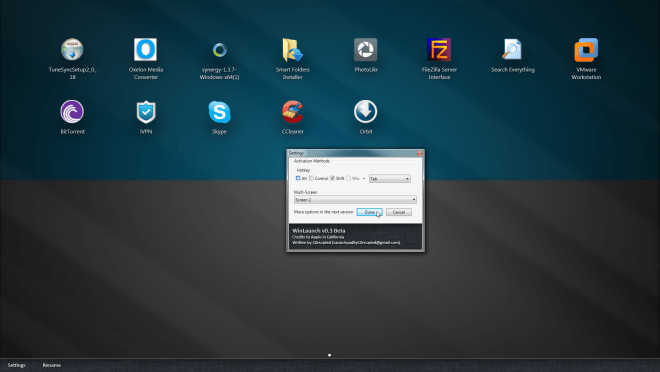In terms of importance, the Dock — the quick-access strip for applications and documents that appears on your iMac’s Desktop — ranks right up there with the command center of a modern nuclear submarine. As such, it had better be easy to customize, and naturally, OS X doesn’t let you down.

Adding applications and extras to the Dock
Similarly, you may add shortcuts to your Dock too. Follow any of the above methods and make the shortcut of the folder or app (you may directly add an app to Dock, but anyway). Now drag that shortcut from Desktop to the rightmost part of Dock (Second left to the Trash icon). Wrapping up These were two easy ways to create shortcut icons on Mac.
- Quick Way to Resize The Dock On Your Mac. The quickest and easiest way to resize the Dock on your Mac is to do it right on the Dock itself, without having to go through the Settings on your Mac. Hover your mouse over the Dock Divider Line which separates the App icons on the Dock from the Trash can icon.
- Figure 1: Drag an icon onto the Dock to add it. You can add several items at the same time to the Dock by selecting them all and dragging the group to the Dock. However, you can delete only one icon at a time from the Dock. Removing an icon from the Dock. To remove an item from the Dock, just drag its icon onto the Desktop.
Why be satisfied with just the icons that Apple places on the Dock? You can add your own applications, files, and folders to the Dock as well.
- Adding applications: You can add any application to your Dock by dragging its icon into the area to the left side of the Dock. You’ll know when you’re in the proper territory because the existing Dock icons obligingly move aside to make a space for it.
Attempting to place an application directly on the right side of the Dock sends it to the Trash, so beware. Note, however, that you can drop an application icon inside a Stack or a folder that already exists at the right side of the Dock.
- Adding individual files and volumes: You can add individual files and volume icons to the Dock by dragging the icon into the area to the right side of the Dock. (Attempting to place these to the left side of the Dock opens the application associated with the contents, which typically isn’t what you intended.) Again, the existing Dock icons move aside to create a space when you’re in the right area. To open the Dock item you’ve added in a Finder window, right-click the icon to display a Dock menu, where you can open documents, run applications, and have other assorted fun, depending on the item you choose.
- Adding several files or a folder: El Capitan uses a feature called Stacks, which I discuss in “Keeping track with Stacks,” to handle multiple files or add an entire folder to the Dock.
- Adding websites: You can drag any URL from Safari directly into the area at the right of the Dock. Clicking that icon automatically opens your browser and displays that page.
To remove an icon from the Dock, just click and drag it off the Dock. Note, however, that the original application, folder, or volume is not deleted — just the Dock icon itself is permanently excused. If you like, you can delete almost any of the default icons that OS X installs on the Dock; only the Finder and Trash icons must remain on the Dock.
Keeping track with Stacks
El Capitan offers Stacks, which are groups of items that you want to place on the Dock for convenience — perhaps the files needed for a project you’re working on, or your favorite game applications.
To create a Stack, just select a folder containing the items and drag the folder to the right side of the Dock. As always, the Dock opens a spot on the right side of the Dock to indicate you’re in the zone.
To display the items in a Stack, just click it:
- If the Stack holds relatively few items, they’re displayed in a really cool-looking arc that Apple calls a fan, and you can click the item you want to open or launch.
- If the Stack is stuffed full of many items, the Stack opens in a grid display, allowing you to scroll through the contents to find what you need.
El Capitan provides display and sorting options for a Stack. Right-click the Stack icon, and you can choose to sort the contents by name, date created or added, date modified, or file type. If you prefer a grid display (no matter how many items the Stack contains) you can choose Grid mode. Choose List to display the Stack’s contents in much the same way as List view mode in a Finder window. List view mode also allows you to view folders in a Stack as nested menu items. Choose Automatic to return to the default view mode.
When set to Display as Stacks, the Stack icon is displayed using icon images from the contents of the folder; if security is an issue, however, choose Display as Folder from the right-click menu to display the Stack as a plain folder icon instead.
You can remove a Stack from the Dock by right-clicking the Stack icon and choosing Options from the menu that appears. Choose Remove from Dock from the submenu that appears. Alternatively, just drag that sucker right off the Dock.
You can also display the contents of a Stack in a Finder window. Right-click the Stack icon, and choose the Open item at the bottom of the pop-up menu.

If you add a folder full of items, the Stack is named after the folder; otherwise, El Capitan does the best job it can in figuring out what to name the Stack.
Apple provides a Stack already set up for you: The Downloads folder, situated next to the Trash, is the default location for any new files that you download using Safari or receive in your email. El Capitan bounces the Download Stack icon to indicate that you’ve received a new item.
Resizing the Dock
You can change the size of the Dock from the Dock settings in System Preferences — but here’s a simpler way to resize the Dock, right from the Desktop.
Move your pointer over the vertical solid line that separates the left side of the Dock from the right side; the pointer turns into a funky vertical line with arrows pointing up and down. This is your cue to click and drag while moving up and down, which expands and shrinks the Dock, respectively.

Icons For Mac Dock
You can also right-click when the funky line pointer is visible to display a menu of Dock preferences. This allows you to change your Dock preferences without the hassle of opening System Preferences and displaying the Dock settings.
Would you like to add frequently used applications or documents to your Dock? Would you like to remove rarely used items from the Dock? If so, below are instructions on how to do this. The Dock is the row of icons that’s typically located across the bottom of the screen, though it can be moved. Apple populates the Dock with items that they think, or want, you to use, but you can customize it to suit your own needs. You can add applications, documents or folders to the dock.
Dock Basics
- The Dock is divided into two, disproportionately sized sections. Look for the dividing line which appears a little bit to the left of the Trash. The left-hand section can contain Application icons. The right-hand section can contain icons for files, folders or web sites.
- When you’ve opened an application on your Mac you’ll see its Dock icon displays a small black dot below it. (Older versions of the Mac operating system displayed either white horizontal bar or a bluefish white circle, both of which are hard to see, if you ask me.)
- Apple populates the Dock with some of its applications. You can rearrange or remove these icons using the instructions below.
- When you open an Application whose icon is not already on the Dock, this application’s icon will temporarily appear on the Dock. When the application is quit its icon will vanish from the Dock.
- The Finder icon, which appears at the far-left end, and the Trash icon, which appears at the the far right-end, can not be moved around or removed. They are locked in place.
- Clicking and holding an icon on the Dock produces a menu of choices. For example, if you click and hold on the Trash icon its menu lets you choose to either open the trash or empty it (if you have files in the trash).
Rearrange Items On The Dock
- To rearrange icons on the Dock, click and drag an icon to either the left or right.
Remove Items From The Dock
- Click and hold on a dock icon to display its menu.
- Select Options
- Select Remove From Dock (If you want to remove a Folder icon, hold down the Control key and then click and hold its icon to see it’s menu.)
Add Applications To The Dock
- There are a few ways to add Applications to the Dock but this one is the one I use most often.
- Click on the Finder icon on the Dock to open a Finder window
- Click on the Go menu, at the top of the screen, select Applications.
- Locate the application that you want to add to the Dock.
- Click and drag this application’s icon to the left-hand section of the Dock. (Make sure you don’t drag this icon on top of another dock icon. Instead, make sure that you see the dock icons scoot to the side to make room for this new icon.)
Move Icons On Mac Dock
Add Files or Folders To The Dock
- Click on the Finder icon on the Dock to open a Finder window
- Navigate to the file or folder that you want to add
- Click and drag this application’s icon to the right-hand section of the Dock (Make sure you don’t drag this icon on top of another dock icon. Instead, make sure that you see the dock icons scoot to the side to make room for this new icon.)
Change The Dock’s Location
Icons For Mac Dock
- Click on the Apple menu and select System Preferences
- Click on the Dock icon
- Locate the Position on screen section and select, Left, Bottom or Right.
Change Mac Dock Icons
You might also be interested in Apple’s Dock overview article.
